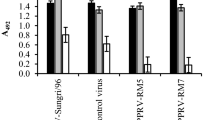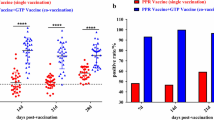Abstract
Virulent isolate of peste des petits ruminants virus (PPRV) of Indian origin (PPRV Jhansi 2003) initially adapted in Vero cells was further propagated in thermo-adapted (Ta) Vero cells grown at 40 °C for attaining thermo-adaption and attenuation of virus for development of Ta vaccine against PPR in goats and sheep. The virus was attenuated up to 50 passages in Ta Vero cells, at which, the virus was found sterile, innocuous in mice and guinea pigs and safe in seronegative goats and sheep. The developed vaccine was tested for its immunogenicity in goats and sheep by subcutaneous inoculation of 100 TCID50 (0.1 field dose), 103 TCID50 (one field dose) and 105 TCID50 (100 field doses) of the attenuated virus along with controls as per OIE described protocols for PPR vaccine testing and were assessed for PPRV-specific antibodies 7–28 days post vaccination (dpv) by PPR competitive ELISA and serum neutralization tests. The PPRV antibodies were detected in all immunized goats and sheep and goats were protective when challenged with virulent PPRV at 28th dpv along with controls for potency testing of the vaccine. The attenuated vaccine did not induce any adverse reaction at high dose (105 TCID50) in goats and sheep and provided complete protection even at low dose (102 TCID50) in goats when challenged with virulent virus. There was no shedding and horizontal transmission of the attenuated virus to in-contact controls. The results indicate that the developed PPR Ta attenuated virus is innocuous, safe, immunogenic and potent or efficacious vaccine candidate alternative to the existing vaccines for the protection of goats and sheep against PPR in the tropical countries like India.


Similar content being viewed by others
References
Balamurugan V, Sen A, Saravanan P, Bhanuprakash V, Patra RC, Swamp D, Singh RK. Potential effect of Acacia arabica on peste des petits ruminants virus replication. Pharm Biol. 2008;46(3):171–9.
Balamurugan V, Sen A, Saravanan P, Singh RP, Singh RK, Rasool TJ, Bandyopadhyay SK. One-step multiplex RT-PCR assay for the detection of PPR virus in clinical samples. Vet Res Commun. 2006;30:655–66.
Balamurugan V, Sen A, Venkatesan G, Yadav V, Bhanot V, Bhanuprakash V, Singh RK. Application of semi-quantitative M gene-based hydrolysis probe (TaqMan) real-time RT-PCR assay for the detection of Peste des petits ruminants virus in the clinical samples for investigation into clinical prevalence of disease. Transbound Emerg Dis. 2010;57:383–95.
Balamurugan V, Sen A, Venkatesan G, Yadav V, Bhanot V, Riyesh T, Bhanuprakash V, Singh RK. Sequence and phylogenetic analyses of the structural genes of virulent isolates and vaccine strains of Peste des petits ruminants virus from India. Transbound Emerg Dis. 2010;57:352–64.
Balamurugan V, Sen A, Venkatesan G, Yadav V, Bhanuprakash V, Singh RK. Isolation and identification of virulent peste des petits ruminants viruses from PPR outbreaks in India. Trop Anim Health Prod. 2010;42:1043–6.
Bandyopadhyay SK, Singh RP, Chandra U. Efficacy of the micro-method of the assessment of neutralizing antibodies following vaccination/infection with rinderpest virus. Indian J Anim Sci. 1999;69:82–4.
Couacy-Hymann E, Roger F, Hurard C, Guillou JP, Libeau G, Diallo A. Rapid and sensitive detection of peste des petits ruminants virus by a polymerase chain reaction assay. J Virol Methods. 2002;100:17–25.
Diallo A, Minet C, Le Goff C, Berhe G, Albina E, Libeau G, Barrett T. The threat of peste des petits ruminants: progress in vaccine development for disease control. Vaccine. 2007;25(30):5591–7.
Diallo A, Taylor WP, Lefevre PC, Provosta A. Attenuation of a virulent PPR strain potential homologous live vaccine. Revue d Elevage et de Medecine Veterinaire des Pays Tropicaux (Paris). 1989;42:311–9.
Forsyth MA, Barrett T. Detection and differentiation of rinderpest and peste des petits ruminants viruses in diagnostic and experimental samples by polymerase chain reaction using P and F gene-specific primers. Virus Res. 1995;39:151–63.
Libeau G, Diallo A, Parida S. Evolutionary genetics underlying the spread of peste des petits ruminants virus. Anim Front. 2014;4(1):14–20.
OIE-World Organisation for Animal Health-Manual of Diagnostic Tests and Vaccines for Terrestrial Animals, chap. 2.7.11. Paris: OIE; 2013. p. 1–14.
Raut A, Singh RK, Malik M, Joseph MC, Baksi CS, Suryanarayana VVS, et al. Development of a thermoresistant tissue culture Rinderpest Vaccine Virus. Acta Virol. 2001;45:235–41.
Reed LJ, Muench HA. A simple method of estimating fifty percent end points. Am J Hyg. 1938;27:493–7.
Riyesh T, Balamurugan V, Sen A, Bhanuprakash V, Venkatesan G, Yadav V, Singh RK. Evaluation of efficacy of stabilizers on the thermostability of live attenuated thermo-adapted Peste des petits ruminants vaccines. Virol Sin. 2011;26(5):324–37.
Rossitter PB, Jessett DM, Taylor WP. Microneutralisation systems for use with different strains of peste des petits ruminants virus and rinderpest virus. Trop Anim Health Prod. 1985;17:75–81.
Santhosh AK, Gomes AR, Hegde R, Rathnamma D, Veeregowda BM, Byregowda SM, Renukaprasad C, Bhanuprakash V, Prabhudas K, Hegde NR, Isloor S. Comparative immunogenicity of two peste des petits ruminants (PPR) vaccines in South Indian sheep and goats under field conditions. Indian J Virol. 2013;24(3):373–9.
Saravanan P, Sen A, Balamurugan V, Rajak KK, Bhanuprakash V, Palaniswami KS, Nachimuthu K, Thangavelu A, Dhinakarraj G, Hegde R, Singh RK. Comparative efficacy of peste des petits ruminants (PPR) vaccines. Biologicals. 2010;38(4):479–85.
Sarkar J, Sreenivasa BP, Singh RP, Dhar P, Bandyopadhyay SK. Comparative efficacy of various chemical stabilizers on the thermo stability of a live-attenuated peste des petits ruminants (PPR) vaccine. Vaccine. 2003;21(32):4728–35.
Sen A, Balamurugan V, Rajak KK, Chakravarti S, Bhanuprakash V, Singh RK. Role of heavy water in biological sciences with an emphasis on thermostabilization of vaccines. Exp Rev Vaccines. 2009;8(11):1587–602.
Singh RK, Balamurugan V, Bhanuprakash V, Sen A, Saravanan P, Yadav MP. Possible control and eradication of peste des petits ruminants from India: technical aspects. Vet Ital. 2009;45(3):449–62.
Singh RP. Production and characterization of monoclonal antibodies to peste des petits ruminants (PPR) virus. PhD Thesis, 2002; Submitted to Deemed University, IVRI, Izatnagar, India.
Singh RP. Control strategies for peste des petits ruminants in small ruminants of India. Rev Sci Tech. 2011;30(3):879–87.
Singh RP, De UK, Pandey KD. Virological and antigenic characterization of two peste des petits ruminants (PPR) vaccine viruses of Indian origin. Comp Immunol Microbiol Infect Dis. 2010;33(4):343–53.
Singh RP, Sreenivasa BP, Dhar P, Bandyopadhyay SK. A sandwich-ELISA for the diagnosis of Peste des petits ruminants (PPR) infection in small ruminants using antinucleocapsid protein monoclonal antibody. Arch Virol. 2004;149:2155–70.
Singh RP, Sreenivasa BP, Dhar P, Shah LC, Babdyopadhyay SK. Development of Monoclonal antibody based competitive-ELISA for detection and titration of antibodies to peste des petits ruminants virus. Vet Microbiol. 2004;8:3–15.
Worrall EE, Litamoi JK, Seck BM, Ayelet G. Xerovac: an ultra rapid method for the dehydration and preservation of live attenuated rinderpest and peste des petits ruminants vaccines. Vaccine. 2000;19(7–8):834–9.
Acknowledgments
The authors thank the Director, Indian Veterinary Research Institute for providing necessary facilities to carry out this work and the staff of Rinderpest and Allied Disease Laboratory and Animal Sheds, Division of Virology, Mukteswar, for their valuable assistance and timely help in carrying out this work. The study in the form of Ad-hoc Scheme (F.No.11-3/2007-GA-II and 1-1/2007-ASR-IV) was funded by Indian Council of Agricultural Research, Government of India, New Delhi, India.
Author information
Authors and Affiliations
Corresponding author
Rights and permissions
About this article
Cite this article
Balamurugan, V., Sen, A., Venkatesan, G. et al. Protective immune response of live attenuated thermo-adapted peste des petits ruminants vaccine in goats. VirusDis. 25, 350–357 (2014). https://doi.org/10.1007/s13337-014-0208-x
Received:
Accepted:
Published:
Issue Date:
DOI: https://doi.org/10.1007/s13337-014-0208-x




